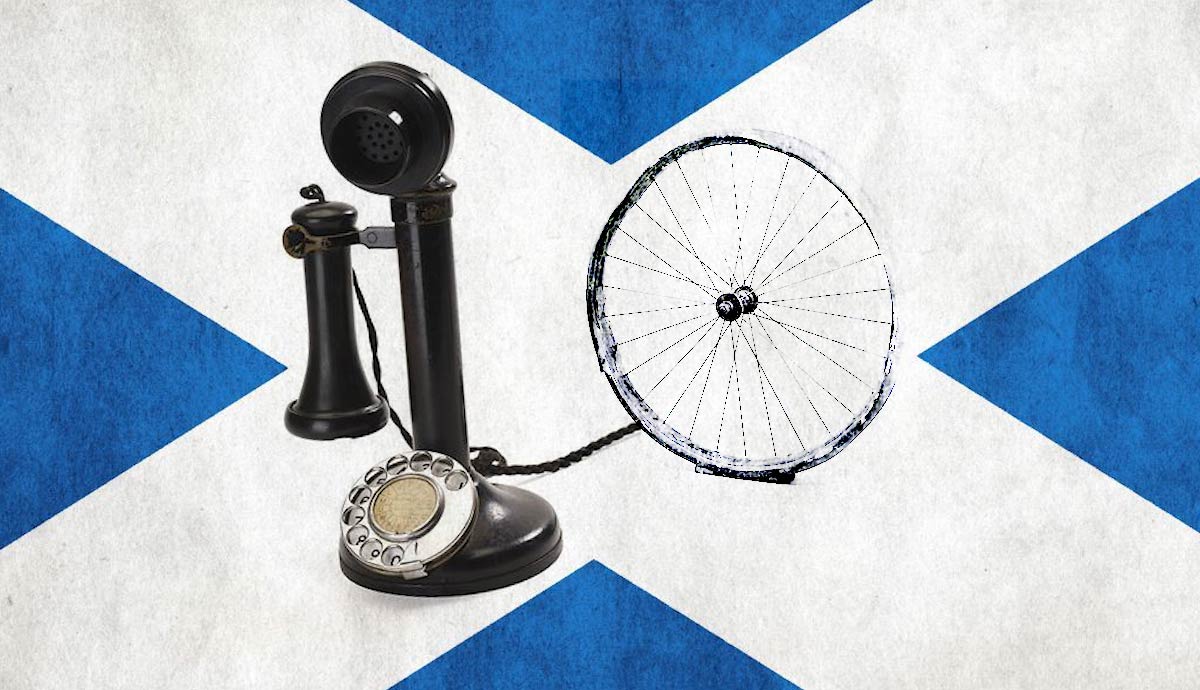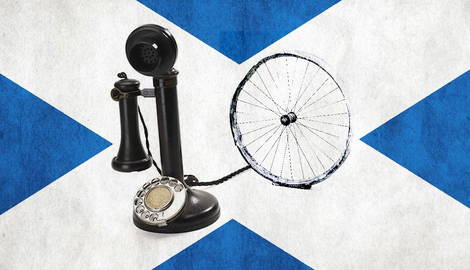
Every so often, an invention comes along that changes the world and the way we view it. Some of those inventions spawned entire industries and acted as the foundation for further inventions that would shape human civilization for centuries to come.
Despite its tiny size and relatively small population, Scotland has been at the forefront of this charge of progress. Per capita, Scotland has an incredibly high success rate when it comes to counting the important inventions gifted to society.
Scotland is a land of rolling hills, beautiful cities and towns, endearing people, questionable cuisine, and, importantly, a land of inventors!
Here are some of the most important Scottish inventors and 7 of the most important inventions.
1. William Cullen: Artificial Refrigeration

A central figure in the Scottish Enlightenment, William Cullen was a learned man who was a physician, agriculturalist, chemist, and professor at the Edinburgh Medical School. Apart from being an instrumental figure in the progress of the medical field, he was also a dedicated teacher, writer, and inventor.
In 1755, Cullen designed a small refrigeration machine, and the following year, he gave the first public demonstration of his process of refrigeration. His invention used a pump to create a vacuum over a container filled with diethyl ether. This process caused the liquid to boil, drawing heat from the surroundings. The process even produced a small amount of ice.
The results of his experiment had no practical application at the time and could not be used commercially. It did, however, form the basis for further experiments through the ages. It was the start of a long series of experiments that eventually led to us having refrigerators in our houses!
2. Alexander Cumming: The “S-trap” Flush Toilet

In 1775, Alexander Cumming changed Western society forever by unveiling his iteration of the flush toilet. However, the evolution and development of the flush toilet goes much further back in history. Using water to flush away effluence was used as early as 3100 BCE in the settlement of Skara Brae in the Orkney Islands, in what is now part of Scotland!
Clay pipes and running water were a feature of sanitation in many places in the ancient world, including Mesopotamia, Egypt, the Indus Valley, Crete, and Rome.
The development of the modern flush toilet started in 1596 with Englishman Sir John Harington. His invention had a flush valve to let water out of the tank and wash down the offending article. However, this design didn’t stop foul smells from wafting through the sewers and creating a stink in the home. It wasn’t until 1775 that the first modern flush toilet was invented.
What made Alexander Cumming’s toilet so special was the inclusion of the “s-trap,” which trapped water in the pipes that connected the toilet to the plumbing.
Of course, the toilet would continue to advance, with more modern features being added until we arrive at the current era, where some Japanese toilets even have the ability to speak to their users. It is to Alexander Cumming that we owe the important feature that is so prevalent in toilets today. That simple bend in the pipes may not seem like much, but its importance cannot be overstated!
3. John Logie Baird: The Television

Of all the inventions throughout history, the television is inarguably one of the most influential creations. Its impact on society and culture throughout the world has been phenomenal, bringing moving pictures and sound into homes everywhere.
Scottish inventor John Logie Baird is credited with having invented the television. His experiments began in the early 1920s, generating beams of light that would pass through a spinning disc with holes in it, allowing images to be scanned, transmitted, and reconverted.

Baird’s machinery was an eclectic mix of biscuit tins, a tea chest, cardboard, hat box lids, and an assortment of other odds and ends. In 1925, his “Televisor” was demonstrated to the public. The quality of the picture was incredibly poor, but the public was wowed not by the quality but by what Baird’s invention represented.
The Post Office licensed Baird’s company, and with the funding, Baird continued his experiments. He was more interested in how the television worked than the actual results. Nevertheless, his contribution to the development of the television was a pivotal moment in world history.
Other inventors would build on Baird’s success and improve the television throughout the decades, eventually bringing us the high definition and clarity we have today.
4. Alexander Graham Bell and the Telephone

Along with the television, the telephone has been one of the most important inventions that shaped human civilization throughout the 20th century. Attributing the invention of the telephone to any one person is a tricky business and one that generates vigorous debate.
Antonio Meucci, an Italian immigrant to the United States, created a “talking telegraph” in 1871 but was forced to abandon his project due to financial hardships.

On February 14th, 1876, lawyers representing inventors Elisha Gray and Alexander Graham Bell went to the patent office to file for the recognition of their employer’s invention. Bell’s lawyer got there first, and as a result, Alexander Graham Bell is known as the father of the telephone.
The electromagnetic telephone as we know it rose out of the experiments in advancing telegraph technology. Today, the inner workings of the telephone have all been replaced with electronics in the cellular phones we carry around with us. But for many decades, it was Bell’s invention that facilitated communication across the whole world.
5. Robert William Thomson & John Boyd Dunlop: The Pneumatic Tire

In 1847, Scotsman Robert William Thomson filed a patent for his pneumatic tire. At the time, rubber production was not advanced enough for Thomson to make a profit off his business, and little came of his invention. It seems it never went into production.
John Boyd Dunlop, unaware of this invention, started experimenting with his own designs in the 1880s. A veterinarian by trade, Dunlop began to tinker with his invention as a result of his young son struggling to ride his tricycle on rough sidewalks. His first creation was unveiled in 1888, and versions of the tire were intended for bicycles and light vehicles. In 1890, he discovered Thomson’s patent but decided to keep the information to himself.

As Dunlop’s success grew, however, the secret couldn’t be hidden, and in 1892, Dunlop’s patent was declared invalid. Despite this considerable setback, Dunlop worked with Dublin-born financier Harvey du Cros to protect the Pneumatic Tyre company, applying new patents to their creations in order to differentiate them from Thomson’s original. The legal challenges were immense, but Dunlop and Du Cros triumphed. Central to this triumph was the application of vulcanization.
Pneumatic Tyre was rebranded as Dunlop Rubber and then Dunlop Tyres.
6. Alexander Fleming: Penicillin

Not so much an invention as a discovery, the properties of the penicillin fungus are a major part of medicine today and have saved countless lives thanks to the experiments of Alexander Fleming.
A chance discovery as Scottish Physician Alexander Fleming returned from a holiday on September 3, 1928, he noticed that a fungal mold had been growing in a petri dish with the Staphylococcus aureus culture. The uncovered petri dish had been left near an open window and been infected with the fungus that had surrounded the bacteria and was stopping it from spreading. Bacteria near the fungus seemed also to be dying. The fungus was a form of Penicillium, later identified as Penicillium rubrum (later renamed P. rubens).
Fleming presented his discoveries but did not pursue the applications with any enthusiasm. The fungus was difficult to isolate, and he did not spend time convincing other scientists to expand on his work.
In 1930, penicillin was used by pathologist Cecil George Paine to treat an infection in infants, but it wasn’t until the early 1940s that penicillin use started to become widespread. From 1943, efforts were made to mass-produce the fungus for medical purposes, and it remains a valuable medicine today.
7. James Clerk Maxwell: Color Photography

In a paper published in 1855, Scottish physicist James Clerk Maxwell suggested the application of the three-color method, which has formed the foundation of all practical chemical and electronic color processes to this day.
In his research, he demonstrated that by using a rotating disc, he could alter the proportions of any of the three colors of light – red, green, and blue. His explanation was simple. He stated that if three black and white photographs were taken of the same scene, a transparency was made of each one, and each transparency projected through one of the three colors, then the superimposition of all three images would show the scene in full color.
A few years later, in 1861, Englishman Thomas Sutton put Maxwell’s theory to the test during a lecture and produced the world’s first color photograph using the three-color method. The subject was a brightly colored ribbon!

The remarkable contribution of Scotland to the world of science through technological innovation has changed the whole world and altered human life throughout the entire world. To be sure, without Scotland and its inventors, the world would be a much poorer place!










